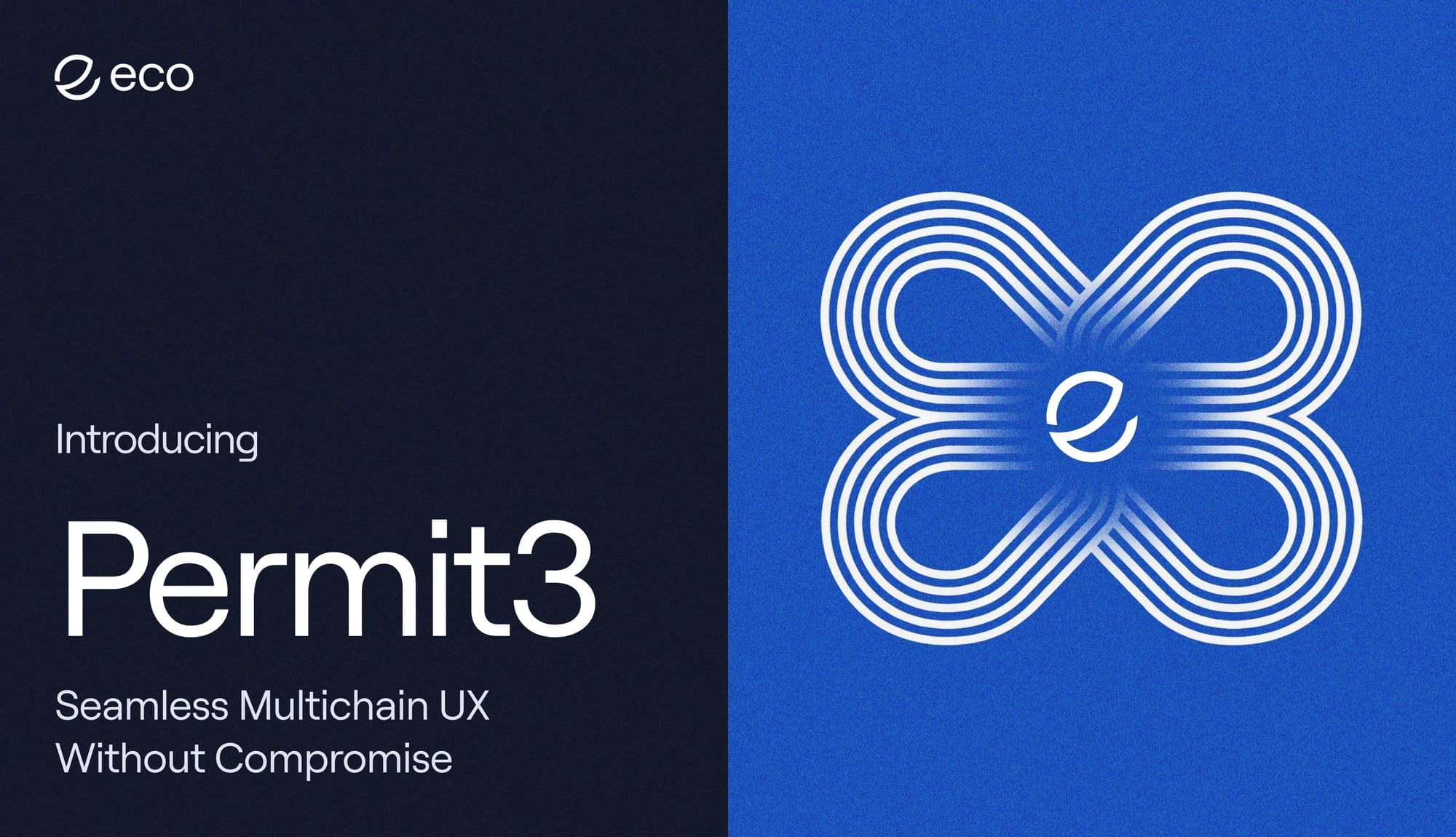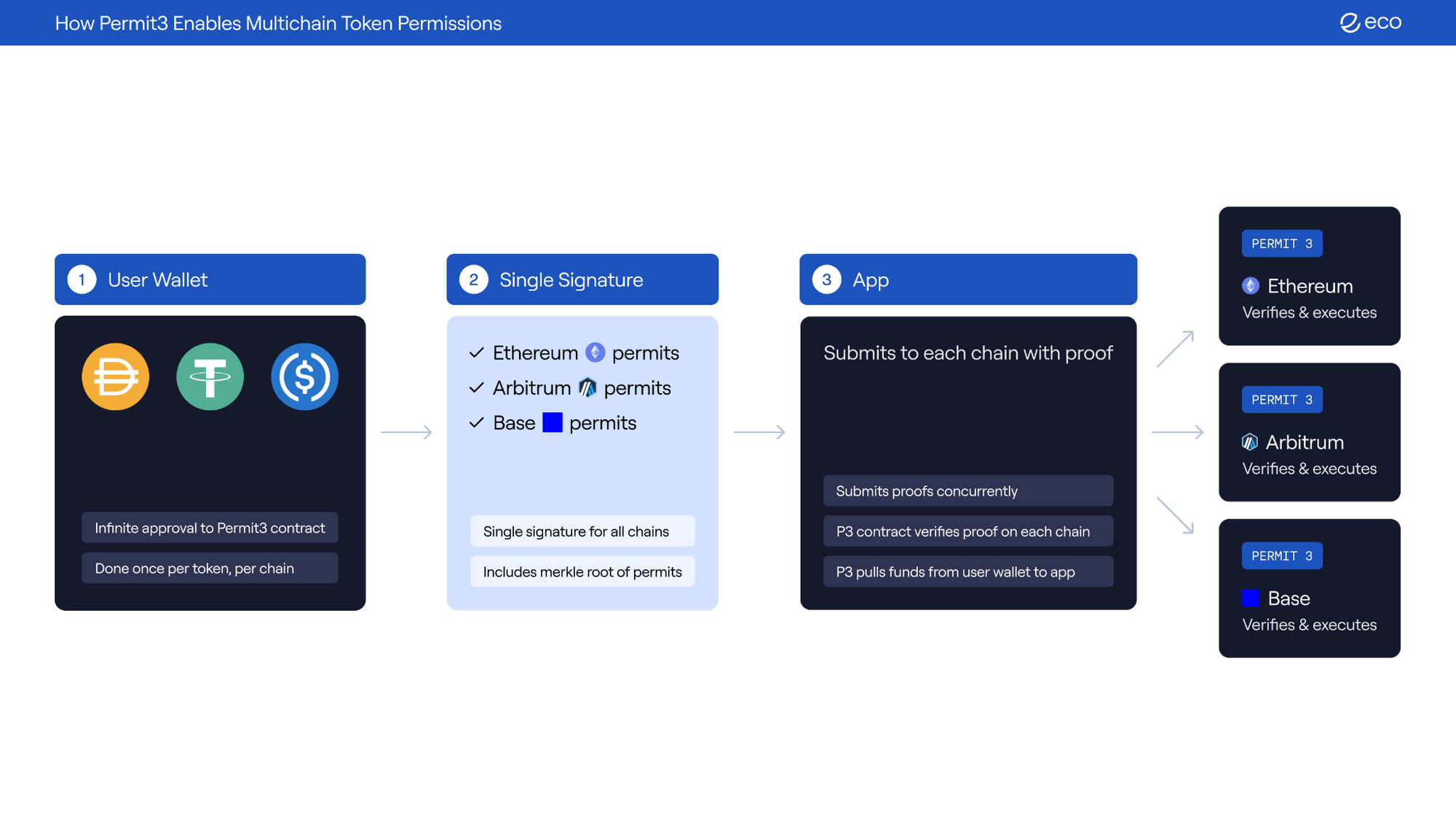Introducing Permit3: Seamless Multichain UX Without Compromise
Extending Permit2 to enable multichain token permissions with full gas abstraction.

Extending Permit2 to enable multichain token permissions with full gas abstraction.
Today, Eco is releasing Permit3, a token approval contract that enables truly unified multichain experiences. We initially developed Permit3 as a solution to enable global stablecoin balances, multi-input intent orders, and greater gas efficiency across any EVM chain. But we also believe the broader ecosystem would benefit from a standardized approach to multi-chain token permissions, so we've extended Permit3 into a general solution and an open protocol that any developer can integrate.
Why token approvals need an upgrade
Permit2 solved many of the original challenges with ERC-20 token approvals: it enabled signature-based approvals for any token, introduced time-bound permissions, and allowed applications to share approvals efficiently. However, Permit2 was designed for single-chain operations, and the multichain landscape has evolved significantly since its introduction.
Today's users operate across multiple chains routinely, but existing approval mechanisms create friction at every step:
- Fragmented authorization architecture: Each chain maintains isolated permission states, forcing users to authenticate identical actions across networks repeatedly
- Native gas token hurdles: Cross-chain actions need native gas tokens on every chain, forcing users to manage multiple gas tokens
These limitations become particularly apparent in scenarios such as cross-chain portfolio rebalancing, executing multi-chain DeFi strategies, or building applications that aggregate user balances across multiple networks.
How Permit3 upgrades Permit2 and improves UX
Permit3 builds upon the proven security model of Permit2 while extending its capabilities to multichain scenarios. The core contract validates signatures containing permit data for multiple chains in a single signature.

The protocol operates independently on each chain without requiring cross-chain synchronization. A single signature contains permit data for multiple chains, but when submitting to a specific chain, only that chain's relevant data needs to be sent along with Merkle proofs representing the other chains' data. This same signature works across all chains because each Permit3 instance validates it locally using the provided proofs, eliminating the need for inter-chain communication. By avoiding cross-chain dependencies, the system eliminates messaging delays, reduces points of failure, and enables concurrent execution across all chains without waiting for confirmations or bridge operations.
The complete list of features and Permit2 comparison can be found in the Eco Docs, but most notably:
- Single signature for cross-chain operations: Permit3 enables users to authorize token operations across multiple blockchains with one signature. Through Unbalanced Merkle Trees, we minimize proof size for expensive chains.
- Direct permit execution without signatures: When the caller has authority (msg.sender is the token owner), Permit3 allows direct execution to set up allowances without requiring signatures. This enables contracts and account abstraction wallets to manage permissions programmatically without the overhead of signature generation and verification.
- Non-sequential nonces for async operations: Permit3 uses non-sequential, async-first nonces (while Permit2 uses bitmap tracking). This enables concurrent operations and allows applications to process multiple signatures in parallel without nonce conflicts, particularly beneficial for high-frequency trading and automated strategies.
- Multi-token support across ERC standards: The protocol provides a unified interface for ERC20, ERC721 NFTs, and ERC1155 semi-fungible tokens. For NFTs and semi-fungible tokens, Permit3 supports both per-token and collection-wide permissions, with specialized encoding for tokenId handling in signed permits.
- Permit2 compatibility and ERC-7702 support: Permit3 implements compatibility with Permit2's transferFrom and allowance functions, allowing integrated contracts to consume permits without changes. Includes witness functionality for attaching arbitrary data. ERC-7702 support enables upgrading user accounts to grant Permit3 access to all tokens without additional signatures or approvals.
Integrate Permit3
Permit3 is deployed as a collection of non-upgradable, unowned, and open-source contracts across all major EVM chains at a universal address. There are two paths for integration:
- Upgrading from Permit2: The protocol maintains full backward compatibility with Permit2 while introducing powerful multichain capabilities that transform how applications handle token permissions.
- New integration: For applications implementing signature-based approvals for the first time, Permit3 offers a streamlined path to multichain token permissions without the complexity of managing per-chain approval states.
To start integrating, read the Eco Docs and the quickstart integration guide. We will be adding integration guides and templates in the coming weeks. We welcome further contributors.
What you can build today
Permit3 enables several compelling use cases that are difficult or impossible with current approval systems:
- Portfolio Rebalancing: Users can authorize rebalancing operations across their entire multichain portfolio with a single signature, allowing automated strategies to execute across any supported network.
- Cross-Chain DeFi: DeFi protocols can offer unified experiences where users provide liquidity, stake, or trade across multiple chains without per-chain approvals.
- Payment Applications: Checkout flows can accept any stablecoin from any supported chain, with Permit3 handling the cross-chain authorization and settlement logic.
- Account Abstracted Experiences: Smart contract wallets can leverage Permit3 to provide seamless multichain experiences where users' balances are effectively unified across networks.
Permit3 represents a significant step toward seamless chain abstraction. By standardizing multichain token permissions, Permit3 enables developers to build applications that feel native to users while operating across the entire blockchain ecosystem. We're excited to see what the community builds with Permit3.
About Eco
Eco is the network that powers real-time money movement across every major stablecoin and blockchain, ensuring dollars flow seamlessly across today's fragmented multichain landscape. Leading apps and protocols integrate Eco to power stablecoin flows where best-in-class execution is required — upgrading stablecoin UX throughout their ecosystems and unifying them all in a thriving Stable Economy.
Website | Eco Docs | Twitter | LinkedIn | YouTube | Discord
About Eco Inc.
Eco Inc. is a blockchain company building software that maximizes money’s value. The company is a founding contributor to the Eco Protocol and the builder of Bend. We expect better from our money, and we want you to as well. That’s what drives us every day.
